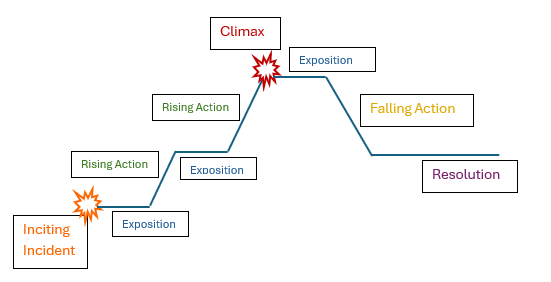5: Writing Standards
- Page ID
- 331423
\( \newcommand{\vecs}[1]{\overset { \scriptstyle \rightharpoonup} {\mathbf{#1}} } \)
\( \newcommand{\vecd}[1]{\overset{-\!-\!\rightharpoonup}{\vphantom{a}\smash {#1}}} \)
\( \newcommand{\dsum}{\displaystyle\sum\limits} \)
\( \newcommand{\dint}{\displaystyle\int\limits} \)
\( \newcommand{\dlim}{\displaystyle\lim\limits} \)
\( \newcommand{\id}{\mathrm{id}}\) \( \newcommand{\Span}{\mathrm{span}}\)
( \newcommand{\kernel}{\mathrm{null}\,}\) \( \newcommand{\range}{\mathrm{range}\,}\)
\( \newcommand{\RealPart}{\mathrm{Re}}\) \( \newcommand{\ImaginaryPart}{\mathrm{Im}}\)
\( \newcommand{\Argument}{\mathrm{Arg}}\) \( \newcommand{\norm}[1]{\| #1 \|}\)
\( \newcommand{\inner}[2]{\langle #1, #2 \rangle}\)
\( \newcommand{\Span}{\mathrm{span}}\)
\( \newcommand{\id}{\mathrm{id}}\)
\( \newcommand{\Span}{\mathrm{span}}\)
\( \newcommand{\kernel}{\mathrm{null}\,}\)
\( \newcommand{\range}{\mathrm{range}\,}\)
\( \newcommand{\RealPart}{\mathrm{Re}}\)
\( \newcommand{\ImaginaryPart}{\mathrm{Im}}\)
\( \newcommand{\Argument}{\mathrm{Arg}}\)
\( \newcommand{\norm}[1]{\| #1 \|}\)
\( \newcommand{\inner}[2]{\langle #1, #2 \rangle}\)
\( \newcommand{\Span}{\mathrm{span}}\) \( \newcommand{\AA}{\unicode[.8,0]{x212B}}\)
\( \newcommand{\vectorA}[1]{\vec{#1}} % arrow\)
\( \newcommand{\vectorAt}[1]{\vec{\text{#1}}} % arrow\)
\( \newcommand{\vectorB}[1]{\overset { \scriptstyle \rightharpoonup} {\mathbf{#1}} } \)
\( \newcommand{\vectorC}[1]{\textbf{#1}} \)
\( \newcommand{\vectorD}[1]{\overrightarrow{#1}} \)
\( \newcommand{\vectorDt}[1]{\overrightarrow{\text{#1}}} \)
\( \newcommand{\vectE}[1]{\overset{-\!-\!\rightharpoonup}{\vphantom{a}\smash{\mathbf {#1}}}} \)
\( \newcommand{\vecs}[1]{\overset { \scriptstyle \rightharpoonup} {\mathbf{#1}} } \)
\( \newcommand{\vecd}[1]{\overset{-\!-\!\rightharpoonup}{\vphantom{a}\smash {#1}}} \)
\(\newcommand{\avec}{\mathbf a}\) \(\newcommand{\bvec}{\mathbf b}\) \(\newcommand{\cvec}{\mathbf c}\) \(\newcommand{\dvec}{\mathbf d}\) \(\newcommand{\dtil}{\widetilde{\mathbf d}}\) \(\newcommand{\evec}{\mathbf e}\) \(\newcommand{\fvec}{\mathbf f}\) \(\newcommand{\nvec}{\mathbf n}\) \(\newcommand{\pvec}{\mathbf p}\) \(\newcommand{\qvec}{\mathbf q}\) \(\newcommand{\svec}{\mathbf s}\) \(\newcommand{\tvec}{\mathbf t}\) \(\newcommand{\uvec}{\mathbf u}\) \(\newcommand{\vvec}{\mathbf v}\) \(\newcommand{\wvec}{\mathbf w}\) \(\newcommand{\xvec}{\mathbf x}\) \(\newcommand{\yvec}{\mathbf y}\) \(\newcommand{\zvec}{\mathbf z}\) \(\newcommand{\rvec}{\mathbf r}\) \(\newcommand{\mvec}{\mathbf m}\) \(\newcommand{\zerovec}{\mathbf 0}\) \(\newcommand{\onevec}{\mathbf 1}\) \(\newcommand{\real}{\mathbb R}\) \(\newcommand{\twovec}[2]{\left[\begin{array}{r}#1 \\ #2 \end{array}\right]}\) \(\newcommand{\ctwovec}[2]{\left[\begin{array}{c}#1 \\ #2 \end{array}\right]}\) \(\newcommand{\threevec}[3]{\left[\begin{array}{r}#1 \\ #2 \\ #3 \end{array}\right]}\) \(\newcommand{\cthreevec}[3]{\left[\begin{array}{c}#1 \\ #2 \\ #3 \end{array}\right]}\) \(\newcommand{\fourvec}[4]{\left[\begin{array}{r}#1 \\ #2 \\ #3 \\ #4 \end{array}\right]}\) \(\newcommand{\cfourvec}[4]{\left[\begin{array}{c}#1 \\ #2 \\ #3 \\ #4 \end{array}\right]}\) \(\newcommand{\fivevec}[5]{\left[\begin{array}{r}#1 \\ #2 \\ #3 \\ #4 \\ #5 \\ \end{array}\right]}\) \(\newcommand{\cfivevec}[5]{\left[\begin{array}{c}#1 \\ #2 \\ #3 \\ #4 \\ #5 \\ \end{array}\right]}\) \(\newcommand{\mattwo}[4]{\left[\begin{array}{rr}#1 \amp #2 \\ #3 \amp #4 \\ \end{array}\right]}\) \(\newcommand{\laspan}[1]{\text{Span}\{#1\}}\) \(\newcommand{\bcal}{\cal B}\) \(\newcommand{\ccal}{\cal C}\) \(\newcommand{\scal}{\cal S}\) \(\newcommand{\wcal}{\cal W}\) \(\newcommand{\ecal}{\cal E}\) \(\newcommand{\coords}[2]{\left\{#1\right\}_{#2}}\) \(\newcommand{\gray}[1]{\color{gray}{#1}}\) \(\newcommand{\lgray}[1]{\color{lightgray}{#1}}\) \(\newcommand{\rank}{\operatorname{rank}}\) \(\newcommand{\row}{\text{Row}}\) \(\newcommand{\col}{\text{Col}}\) \(\renewcommand{\row}{\text{Row}}\) \(\newcommand{\nul}{\text{Nul}}\) \(\newcommand{\var}{\text{Var}}\) \(\newcommand{\corr}{\text{corr}}\) \(\newcommand{\len}[1]{\left|#1\right|}\) \(\newcommand{\bbar}{\overline{\bvec}}\) \(\newcommand{\bhat}{\widehat{\bvec}}\) \(\newcommand{\bperp}{\bvec^\perp}\) \(\newcommand{\xhat}{\widehat{\xvec}}\) \(\newcommand{\vhat}{\widehat{\vvec}}\) \(\newcommand{\uhat}{\widehat{\uvec}}\) \(\newcommand{\what}{\widehat{\wvec}}\) \(\newcommand{\Sighat}{\widehat{\Sigma}}\) \(\newcommand{\lt}{<}\) \(\newcommand{\gt}{>}\) \(\newcommand{\amp}{&}\) \(\definecolor{fillinmathshade}{gray}{0.9}\)Concrete Content. “Creative” doesn’t have to mean “abstract.” The goal is still to offer a solid story and a vivid picture for your reader. If you are telling about a grumpy dog you had as a kid, watch out for the “grumpy” abstraction. This is where the rules of academic writing still apply: make a claim and offer evidence. Certainly describe your dog as “grumpy,” but make it concrete after that. Is it a facial expression, a sound he makes, the way he moves under the table every time you try to pet him?
Narrative Structure. A clear story has a set of important parts. You have probably seen this model when discussing story structure:

This image is everywhere. Known as Freytag’s pyramid, it was conceptualized in the mid-nineteenth century by a German playwright and novelist named, surprisingly, Gustav Freytag. CITE THIS

Sean Glatch of writers.com notes that Freytag’s pyramid as a story structure is fairly universal, but most common in Western culture stories. He also acknowledges that the exact order in the diagram can be fluid. “Though some literary works break the traditional narrative structure of Freytag’s Pyramid or try to invert it, every story has a relationship to these five dramatic elements.”



Concise Wording
Watch out for beginning sentences such as “Now…” or, a favorite phrase of so many students when jumping into description: “I remember…” It’s implied that you remember because you’re writing the memory. Get rid of those opening words as you revise. Likewise, look out for modifiers such as “really, very, extremely, just…” Most college writing center websites have several suggestions for replacing “very _____” with a much more vivid descriptive word. Every word should have a job.
Recently retired managing editor of Random House publishing Benjamin Dreyer makes no secret of his disdain for modifiers like “very:”
For one thing, “very” is a fraud, masquerading as a strengthener when it merely wheedles and pleads. To call someone “brilliant” is to make a bold assertion; to call someone “very brilliant” attempts to persuade others of something one appears not to truly believe. Moreover, it’s a dull adverb and encourages duller adjectives. What, after all, is “very hungry” compared with “ravenous”? What’s “very sad” up against “despondent”? Who’d want to be “very strong” when you might be “herculean”?
Concise doesn’t always mean short. It means that every word on the page is crystal clear and is contributing to the meaning of the essay.
Some words have no meaning in various contexts. For instance, what does “things” mean?
Here are a few examples of the use of “things” in my own social media posts over the past five years. Note that each of these “things” could be replaced with more specific and concrete words that would enhance the meaning of the message.
- Maintaining attention on a task for more than 30 minutes.
- Knowing when it's my turn to talk (stresses the heck out of me and always has).
- Being nice to ANYONE for longer than 1 hour and ten minutes.
- Cooperating.
- Sitting still for longer than seven minutes.
- Acting like a grown-up.
- Keeping my language appropriate for any sustained time.
Some of my favorite -ings are: yelling, hiking, dancing, and singing. None of these go over very well in meetings.
~Peanut Butter Chex
~Zoey's Extraordinary Playlist (Hulu show)
~Kickboxing and ab workouts on Amazon Prime
~Painting the windows with liquid acrylic
~Kate DiCamillo (just kidding--I was already in love with her--but Sam has been reading one of her books to me, and it makes me laugh so much)
~Having my son read to me
Have things been awesome inside my head? Nope. But actually, lots of things have been pretty awesome.
Dialogue. Can you do that? Yep, you absolutely can. Find a nonfiction story with great dialogue. SEDARIS ON THE PLANE

